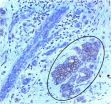(Press-News.org) PHILADELPHIA – Overexpression or hyperactivation of ErbB cell-surface receptors drives the growth of many breast cancers. Drugs, like Herceptin, that block the receptors' signals halt tumor progression in some patients. However, not all patients' tumors respond, with some becoming resistant over time. Different drugs that interfere with other steps in the signaling pathway may improve the response of patients, yet little is known about these molecules.
Now, Marcelo G. Kazanietz, PhD, professor of Pharmacology at the University of Pennsylvania School of Medicine and colleagues, report that a protein called P-Rex1 is crucial for signal transmission from ErbB receptors. What's more, they found that P-Rex1 is overexpressed in nearly 60 percent of breast cancer samples tested and patients whose tumors express P-Rex1 were more likely to develop metastasis, compared with those whose tumors did not express P-Rex1.
"We identified a downstream target of the ErbB receptors which seems to be crucial for cancer cell proliferation, migration, and metastasis," Kazanietz says. "Understanding how this pathway works should allow us to find new drugs or therapeutic approaches in the future."
The team's research is featured on the cover of the December 22 issue of Molecular Cell.
A Well-Known Family
The ErbB family of receptors is well known in the cancer world. The family includes the epidermal growth factor receptor (EGFR, also known as ErbB1); ErbB2 (also known as HER2/neu), which is the target of Herceptin; as well as ErbB and ErbB4.
Previous work from Kazanietz and others suggested the receptors might rely on small proteins in the Rac pathway to help transmit their signal. To find out if that was the case, Kazanietz and colleagues examined human breast cancer cell lines and found that one Rac pathway protein, P-Rex1, is overexpressed in numerous cell lines compared with normal mammary cells. The team also found that P-Rex1 is present in some breast tumors, particularly those that express the Her2/neu receptor or estrogen receptor and belong to the luminal subtype.
"We found that about two-thirds of the patient samples had very high levels of P-Rex1 expression in tumor cells in their lymph nodes," Kazanietz says. "There seems to be a correlation between P-Rex1 expression in the tumor cells and the capacity of these cells to metastasize. And since P-Rex1 is likely to be essential for cell migration and migration is essential for metastasis, we believe blocking this pathway could reduce the risk of metastasis."
P-Rex1 may be important for several other cancer-promoting pathways. For example, estrogen-receptor signaling also appears to rely on P-Rex1, which means that targeted inhibitors of P-Rex1 might improve responses to anti-estrogen therapies such as tamoxifen.
The authors also found that P-Rex1 is also used by another receptor, CXCR4, which has recently shown up in many cancer studies. Despite being used in numerous pathways during cancerous growth, P-Rex1 is not expressed in many normal tissues. "That gives us a very good target. It is really cancer specific," Kazanietz says. "What's more, as P-Rex1 is expressed in some subtypes of breast tumors, it may be an excellent prototype for future personalized medicine."
Preclinical data from other groups supports the importance of the Rac pathway in cancer, according to Kazanietz. And small molecule inhibitors that block proteins in the Rac pathway appear to have strong anti-cancer effects in model systems, though their use in patients still needs to be tested.
INFORMATION:
This work has been supported by grants from the National Cancer Institute and the Susan Komen Foundation for the Cure.
Maria Soledad Sosa and Cynthia Lopez-Haber from the Penn Department of Pharmacology were co-first authors on the study. Additional co-authors include Hongbin Wang and Mark A. Lemmon from Penn; Chengfeng Yang from Michigan State University, East Lansing; John M. Busillo, Jiansong Luo, and Jeffrey L. Benovic from Thomas Jefferson University, Philadelphia; Andres Klein-Szanto, from Fox-Chase Cancer Center, Philadelphia; Hiroshi Yagi and J. Silvio Gutkind from the National Institute of Dental and Craniofacial Research, Bethesda, MD; and Ramon E. Parsons from Columbia University Medical Center, New York.
Penn Medicine is one of the world's leading academic medical centers, dedicated to the related missions of medical education, biomedical research, and excellence in patient care. Penn Medicine consists of the University of Pennsylvania School of Medicine (founded in 1765 as the nation's first medical school) and the University of Pennsylvania Health System, which together form a $3.6 billion enterprise.
Penn's School of Medicine is currently ranked #2 in U.S. News & World Report's survey of research-oriented medical schools, and is consistently among the nation's top recipients of funding from the National Institutes of Health, with $367.2 million awarded in the 2008 fiscal year.
Penn Medicine's patient care facilities include:
The Hospital of the University of Pennsylvania – the nation's first teaching hospital, recognized as one of the nation's top 10 hospitals by U.S. News & World Report.
Penn Presbyterian Medical Center – named one of the top 100 hospitals for cardiovascular care by Thomson Reuters for six years.
Pennsylvania Hospital – the nation's first hospital, founded in 1751, nationally recognized for excellence in orthopaedics, obstetrics & gynecology, and psychiatry & behavioral health.
Additional patient care facilities and services include Penn Medicine at Rittenhouse, a Philadelphia campus offering inpatient rehabilitation and outpatient care in many specialties; as well as a primary care provider network; a faculty practice plan; home care and hospice services; and several multispecialty outpatient facilities across the Philadelphia region.
Penn Medicine is committed to improving lives and health through a variety of community-based programs and activities. In fiscal year 2009, Penn Medicine provided $733.5 million to benefit our community.
Penn researchers identify potential target for breast cancer therapy
Implications for blocking metastasis and improving responses to existing therapies
2010-12-23
ELSE PRESS RELEASES FROM THIS DATE:
New annotated database sifts through mountains of sequencing data to find gene promoters
2010-12-23
Researchers at The Wistar Institute announce the release of an online tool that will help scientists find "gene promoters"—regions along a DNA strand that tell a cell's transcription machinery where to start reading in order to create a particular protein. The Mammalian Promoter Database (MPromDb) integrates the genome sequencing data generated at Wistar with publicly available data on human and mouse genomics. MPromDb pinpoints known promoters and predicts where new ones are likely to be found, the researchers say.
"Several complete genome sequences are available, including ...
Genome of extinct Siberian cave-dweller linked to modern-day humans
2010-12-23
Researchers have discovered evidence of a distinct group of "archaic" humans existing outside of Africa more than 30,000 years ago at a time when Neanderthals are thought to have dominated Europe and Asia. But genetic testing shows that members of this new group were not Neanderthals, and they interbred with the ancestors of some modern humans who are alive today.
The journal Nature reported the finding this week. The National Science Foundation's Behavioral and Cognitive Sciences Division partially funded the research.
An international team of scientists led by Svante ...
Growing hypoxic zones reduce habitat for billfish and tuna
2010-12-23
Billfish and tuna, important commercial and recreational fish species, may be more vulnerable to fishing pressure because of shrinking habitat, according to a new study published by scientists from NOAA, The Billfish Foundation, and University of Miami Rosenstiel School of Marine and Atmospheric Science.
An expanding zone of low oxygen, known as a hypoxic zone, in the Atlantic Ocean is encroaching upon these species' preferred oxygen-abundant habitat, forcing them into shallower waters where they are more likely to be caught.
During the study, published recently in ...
Ever-sharp urchin teeth may yield tools that never need honing
2010-12-23
MADISON – To survive in a tumultuous environment, sea urchins literally eat through stone, using their teeth to carve out nooks where the spiny creatures hide from predators and protect themselves from the crashing surf on the rocky shores and tide pools where they live.
The rock-boring behavior is astonishing, scientists agree, but what is truly remarkable is that, despite constant grinding and scraping on stone, urchin teeth never, ever get dull. The secret of their ever-sharp qualities has puzzled scientists for decades, but now a new report by scientists from the ...
Study shows drifting fish larvae allow marine reserves to rebuild fisheries
2010-12-23
CORVALLIS, Ore. – Marine ecologists at Oregon State University have shown for the first time that tiny fish larvae can drift with ocean currents and "re-seed" fish stocks significant distances away – more than 100 miles in a new study from Hawaii.
The findings add credibility to what scientists have believed for some time, but until now been unable to directly document. The study also provides a significant demonstration of the ability of marine reserves to rebuild fishery stocks in areas outside the reserves.
The research was published this week in PLoS One, a scientific ...
University of Minnesota discovery suggests a new way to prevent HIV from infecting human cells
2010-12-23
Researchers at the University of Minnesota have discovered how HIV binds to and destroys a specific human antiviral protein called APOBEC3F. The results suggest that a simple chemical change can convert APOBEC3F to a more effective antiviral agent and that shielding of a common feature shared by related proteins may yield a similar outcome.
This discovery highlights the potential for a novel approach to combating HIV/AIDS that would seek to stabilize and harness the innate antiviral activity of certain human proteins, according to lead author John Albin, a researcher ...
Pterygotid sea scorpions: No longer terror of the ancient seas?
2010-12-23
BUFFALO, NY (December 22, 2010) -- Experiments by a team of researchers in New York and New Jersey have generated evidence that questions the common belief that the pterygotid eurypterids ("sea scorpions") were high-level predators in the Paleozoic oceans. This group, which ranged the seas from about 470 to 370 million years ago (long before the dinosaurs appeared), included the largest and, arguably, scariest-looking arthropods known to have evolved on planet Earth. Reaching lengths of 2 ½ meters with a body supported by well-developed legs, and armed with a pair of forward-facing ...
Mount Sinai researchers make major breakthrough in melanoma research
2010-12-23
In a breakthrough that could lead to new treatments for patients with malignant melanoma, researchers from Mount Sinai School of Medicine have discovered that a particular protein suppresses the progression of melanoma through regulation of an oncogene, or gene responsible for cancer growth. The study is published in the December 23 issue of Nature.
Researchers studied the natural progression of melanoma using mouse and human cells, as well as patient samples and determined that the presence of a specific histone variant, which is a protein that helps package DNA, was ...
Why does dialysis fail?
2010-12-23
A protein implicated in the development of vascular diseases may also contribute to the failure of arteriovenous (AV) fistulas created for vascular access in dialysis patients, according to a study appearing in an upcoming issue of the Journal of the American Society of Nephrology (JASN).
"Our findings raise the possibility that monocyte chemoattractant protein-1 (MCP-1) may contribute to the relatively poor outcomes regarding the function and longevity of human hemodialysis AV fistulas," comments Karl A. Nath, MB.ChB (Mayo Clinic, Rochester, MN).
AV fistulas are the ...
America's stroke belt partially fueled by fried fish
2010-12-23
BIRMINGHAM, Ala. – Eating a Southern staple, fried fish, could be one reason people in Alabama and across the "stroke belt" states are more likely than other Americans to die of a stroke, according to a study published in the December 22, 2010, online issue of Neurology, the medical journal of the American Academy of Neurology (AAN).
In the stroke belt states – Alabama, Arkansas, Georgia, Louisiana, Mississippi, North Carolina, South Carolina and Tennessee – the risk of dying from stroke is higher than in other parts of the country. In Alabama, the stroke death rate ...
LAST 30 PRESS RELEASES:
Mysterious iron ‘bar’ discovered in famous nebula
World-first tool reduces harmful engagement with AI-generated explicit images
Learning about public consensus on climate change does little to boost people’s support for action, study shows
Sylvester Cancer Tip Sheet for January 2026
The Global Ocean Ship-Based Hydrographic Investigations Program (GO-SHIP) receives the Ocean Observing Team Award
Elva Escobar Briones selected for The Oceanography Society Mentoring Award
Why a life-threatening sedative is being prescribed more often for seniors
Findings suggest that certain medications for Type 2 diabetes reduce risk of dementia
UC Riverside scientists win 2025 Buchalter Cosmology Prize
SETI Institute opens call for nominations for the 2026 Tarter Award
Novel theranostic model shows curative potential for gastric and pancreatic tumors
How beige fat keeps blood pressure in check
Fossils reveal ‘latitudinal traps’ that increased extinction risk for marine species
Review: The opportunities and risks of AI in mental health research and care
New map reveals features of Antarctic’s ice-covered landscape
Beige fat promotes healthy vascular function and blood pressure in mice
Chronic low-dose pesticide exposure reduces the life span of wild lake fish, China-based study shows
Tiny earthquakes reveal hidden faults under Northern California
Long-term pesticide exposure accelerates aging and shortens lifespan in fish
Professor Tae-Woo Lee's research group develops groundbreaking perovskite display technology demonstrating the highest efficiency and industry-level operational lifetime
The “broker” family helps tidy up the cell
Ecology: Mummified cheetahs discovery gives hope for species’ Arabic reintroduction
Researchers survey the ADHD coaching boom
Air pollution and cardiac remodeling and function in patients with breast cancer
Risk of suicide in patients with traumatic injuries
Post–intensive care syndrome
The lifesaving potential of opioid abatement funds
The Frontiers of Knowledge Award goes to Allan MacDonald and Pablo Jarillo-Herrero for their discovery of the “magic angle” enabling science to transform and control the behavior of new materials
Discovery reveals how keto diet can prevent seizures when drugs fail
JMIR Publications and Sikt announce pilot flat-fee unlimited open access partnership
[Press-News.org] Penn researchers identify potential target for breast cancer therapyImplications for blocking metastasis and improving responses to existing therapies


